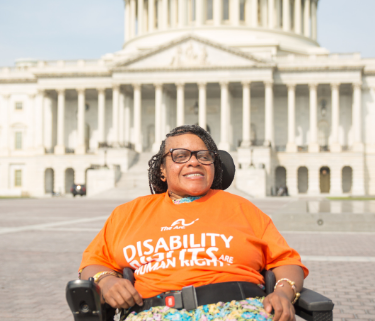By Micki, Grassroots Advocate

My husband and I consider ourselves to be informed parents. When our twin sons Zach and KC were diagnosed with intellectual disability in infancy, we tried to learn all we could to be a good mom and dad. We attended educational programs, joined local organizations that focused on families like ours, and did what we thought was best for our sons.
When they reached the age of 18, we were advised to apply for Supplemental Security Income, a federal income program for those 18 and older who are blind, have a disability, or are aged and have very little income. That went without a hitch. A few years later, one of our sons received a letter from Social Security stating that because he had worked for several years in the community, his benefits would switch from SSI to SSDI, Social Security Disability Insurance, a program for those with disabilities who are part-time workers. He qualified because after graduating from high school, he started working as a front-end clerk/bagger at a supermarket. It has always been and because of our son’s disability, will always have to be, part-time work. He has continued to work in this position for 21 years. He is very proud of this achievement. Again, the switch from SSI to SSDI went without us having to complete any paperwork.
During the first few years that he worked, we were still figuring out how much work he could do. On occasion, the store manager wanted him to put in extra hours because another employee called in sick or didn’t show up to work. It was difficult for him to say no, even if he couldn’t really manage the work. We received a few letters from Social Security stating that he earned too much money when that happened. We spoke to someone from Social Security, but nothing was said about him losing out on higher benefits when his parents retired or passed away. Nor was anything explained to us about how much he could earn while still maintaining benefits. Since he continued to receive payments, we assumed the past problems were just that: in the past.
Foolish assumption.
Some 15 years later, in 2016, when my husband turned 66 and applied for Social Security, he requested that Zach and KC receive SSDI benefits as Disabled Adult Children (DAC) under his work record. DAC benefits would be far more generous than our sons’ own benefits because my husband worked for many more years and also earned more. My husband and I were counting on these benefits to help our sons with their living expenses when we were no longer able to provide financial support. My husband was told that our son who was the front-end clerk would never be able to receive DAC benefits because he earned too much money a few times, occurrences that took place 14 and 15 years ago. Social Security sent us a document showing when his income was too high—it was seven times total, and each time was under $40.
What should we do? Everyone we spoke with was stumped, including attorneys who specialize in denied Social Security Disability applications. With much persistence, we eventually found someone who explained that the things our son had paid for to help him work, like the medication he took to help him focus or the costs of his job coach, could be used to offset the income that exceeded Social Security’s requirements. We learned these are called Impairment Work Related Expenses, IRWEs.
Even though we’d been told that throwing away backup documents from tax filings after seven years was safe, we never did. Luckily, we had the receipts showing those costs which filled a box large enough for a 10-ream case of paper. We took it to the local Social Security office and requested that they review the materials and reconsider our son’s denial of DAC. The Social Security employee was taken aback by the number of documents in the box. He said he wasn’t allowed to work overtime and had no idea how long it would take him to go through it all!
After several nerve-wracking months, we heard from Social Security. They reversed their decision. Our son was approved as a DAC!
There are many families like ours who had and/or continue to experience a similar nightmare. Many of our loved ones work part-time in jobs with fluctuating hours which results in income varying from one month to another. Countless families don’t know about IRWEs or understand the complex rules of Social Security. We are all understandably terrified of doing anything that might put our children’s future benefits in jeopardy. Some find it easier to have their family member not work at all, thereby isolating them from the community and depriving them of self-worth.
The current law is a huge disincentive to work and it’s just too complicated.
Our son is now living by himself in the community. Being self-sufficient means the world to him. His DAC benefits along with his limited earnings cover his expenses, such as rent, utilities, groceries, etc. Without the SSDI DAC benefits, he would no longer be able to live independently in the community.
Parents of adults with intellectual disabilities want the assurance that their loved ones will continue to have meaningful lives after they’re gone. Knowing that their adult children can work and maintain DAC benefits is one critical way of guaranteeing that—the law needs to change.
Find out how you can help Micki’s family and others in the same position.
Learn more and act now!
 I live in Silver Spring, Maryland. I am on the autism spectrum and have anxiety, ADD, seizures, and a learning disability. I am writing to talk about the importance of helping people with disabilities get their student loans discharged, including ending the 3 year monitoring period. As the Biden Administration works to address student loan debt for people with disabilities, it is critically important that the application process be easier and we eliminate the 3 year monitoring period for work earnings. Student loans create a major financial hardship on people like me and many others with disabilities, especially those who live on their own in expensive areas. The amount of loans that I had discharged was around $1,177 which is just slightly less than what I pay in monthly rent for my studio apartment. No one with a disability should have to choose between paying for rent or basic needs and student loans. Many of us in the disability community struggle with finding jobs that pay livable wages where we make enough to live comfortably off public benefits. Benefit cliffs often force us to make big trade-offs between working and needing to stay eligible for public benefits. Some people with disabilities have their Social Security benefits cut to pay their student loans and that isn’t fair.
I live in Silver Spring, Maryland. I am on the autism spectrum and have anxiety, ADD, seizures, and a learning disability. I am writing to talk about the importance of helping people with disabilities get their student loans discharged, including ending the 3 year monitoring period. As the Biden Administration works to address student loan debt for people with disabilities, it is critically important that the application process be easier and we eliminate the 3 year monitoring period for work earnings. Student loans create a major financial hardship on people like me and many others with disabilities, especially those who live on their own in expensive areas. The amount of loans that I had discharged was around $1,177 which is just slightly less than what I pay in monthly rent for my studio apartment. No one with a disability should have to choose between paying for rent or basic needs and student loans. Many of us in the disability community struggle with finding jobs that pay livable wages where we make enough to live comfortably off public benefits. Benefit cliffs often force us to make big trade-offs between working and needing to stay eligible for public benefits. Some people with disabilities have their Social Security benefits cut to pay their student loans and that isn’t fair.















